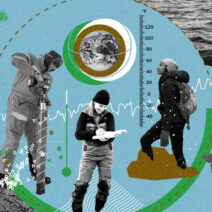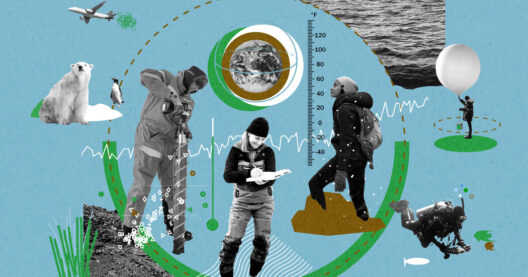Global climate change is one of the most pressing challenges of our time, encompassing complex interactions between various elements of the Earth’s systems. While the conversation often focuses on singular aspects—like atmospheric changes—the reality is more intricate. One cannot discuss ozone without acknowledging its relationship to the oceans. As vital components of the global ecosystem, the interplay between atmospheric conditions and marine environments shapes our planet in profound ways.
Ozone, found in both the stratosphere and the troposphere, serves as a protective shield against harmful ultraviolet (UV) radiation from the sun. Stratospheric ozone plays a crucial role by absorbing roughly 95% of the sun’s harmful UV rays. However, ozone at ground level acts as a pollutant, formed by the interaction of sunlight with pollutants like volatile organic compounds and nitrogen oxides. This duality underscores the complexities inherent in our atmosphere—a mere shift in balance can have far-reaching implications.
Simultaneously, the world’s oceans are absorbing approximately 30% of atmospheric carbon dioxide emissions, which leads to ocean acidification. This process not only threatens marine life but also disrupts the delicate balance that sustains oceanic ecosystems. Coral reefs, often dubbed the “rainforests of the sea,” serve as exemplary indicators of this intersection of atmospheric and oceanic health. They rely on a stable environment to thrive; elevated temperatures and acidic waters lead to coral bleaching, a phenomenon where corals expel the algae they depend on for nourishment, resulting in white, lifeless reefs.
Moreover, the rise in global temperatures catalyzed by climate change cascades through various environmental systems. Warmer oceans induce more violent weather patterns and cyclonic activities, which, in turn, influence the ozone layer. For instance, significant hurricanes can release large amounts of water vapor into the stratosphere, where it can chemically react with ozone. This interaction diminishes ozone concentrations, further exacerbating UV exposure on Earth’s surface and jeopardizing both terrestrial and marine life.
The ocean-atmosphere connection does not stop with weather patterns. It also plays a transformative role in biogeochemical cycles. As oceans regulate the climate, they serve as critical carbon sinks, absorbing a considerable portion of anthropogenic emissions. The persistent increase in ocean temperatures, however, alters these cycles, affecting phytoplankton populations that serve as the foundation of marine food webs. These microscopic organisms absorb significant amounts of carbon dioxide for photosynthesis; a decline in their populations due to warming waters dramatically impacts global carbon levels.
This intriguing relationship between the atmosphere and oceans is emblematic of a broader ecological connectivity. Ecosystems do not exist in isolation. The pollution that affects the ozone layer travels through interconnected air currents and atmospheric systems, eventually depositing harmful substances into ocean waters. This pollution not only depletes oxygen levels but also leads to hypoxic zones—areas in the ocean with insufficient oxygen for marine life to thrive. Such zones disrupt migration patterns and breeding cycles, highlighting the cascading impacts of human-induced changes.
Climate change poses a direct challenge to both atmospheric and marine health. The carbon emissions that contribute to warming temperatures and altered weather patterns inevitably lead to sea-level rise and ecosystem degradation. Alarmingly, glacial and polar ice melt exacerbates these effects by diluting the salinity of ocean waters, thereby disrupting currents that are vital for nutrient distributions across different marine zones.
Understanding the implications of various processes can shift perspectives. When exploring the fragility of ecosystems, one must acknowledge that atmospheric health directly correlates with ocean well-being, painting a complex and compelling picture of our planet’s climate system. This interconnectedness urges a reevaluation of how climate activism is approached. Rather than viewing atmospheres and oceans as separate domains, there’s a pressing need for a holistic view that acknowledges their interdependence. This shift in understanding can enhance policy-making and inspire more robust climate action.
The path forward lies in fostering public curiosity. By educating individuals on the implications of environmental choices, we can stimulate a movement towards sustainability that encompasses both atmospheric and oceanic conservation. For instance, implementing stricter regulations on emissions can reduce tropospheric ozone pollution while also mitigating the impact on marine ecosystems. It is equally critical to support ocean conservation initiatives that address climate change from a multi-faceted perspective.
Actions rooted in understanding the interconnectedness of these elements can catalyze significant progress. Innovations in technology focusing on carbon capture, renewable energy advancements, and marine restoration initiatives not only target climate change but also fortify resilience in both the atmosphere and oceans. From biodiversity preservation to ecosystem restoration, every effort counts.
In conclusion, the intertwining forces of ozone and oceans epitomize the complexity of global climate dynamics. By exploring these relationships and their implications, one can uncover a deeper understanding of our responsibility toward the planet. The urgency of climate action is undeniable, yet it is tempered by a promise—a promise that through knowledge and understanding, we can forge a sustainable future that safeguards both our skies and seas.




